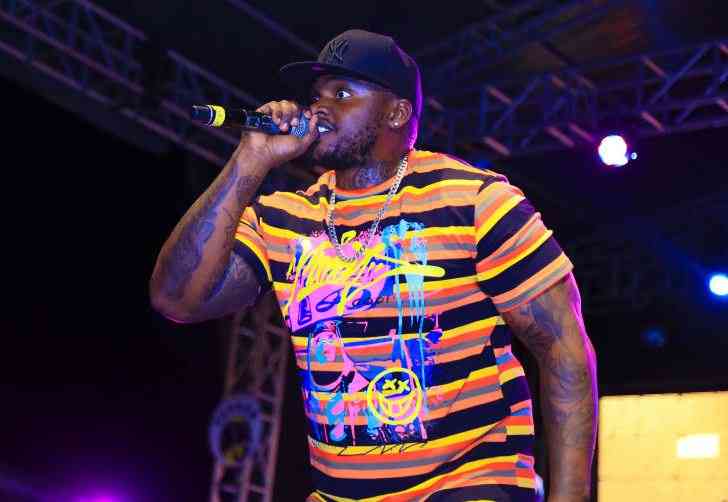
Hip-hop guru Kaligraph Jones performs during the Tusker Nexter talent search in Mtwapa Kilifi County. (Courtesy)
Since independence, Kenyan musicians have developed unique ways of performing and writing music.
It was in the mid-20th century that the genres of Benga, Bango, and Taarab were created by local musicians, who blended traditional rhythms and musical styles with Western instruments, like the electric guitar.
By the time we gained independence in 1963, most of our traditional ways of making music were altered due to our interactions with the West during colonialism.
In 1967, British ethnomusicologist John Roberts said that "the young men and women of Kenya owe allegiance to Elvis Presley, Cliff Richards, Jim Reeves, and to a modern electric-guitared Swahili language popular music, which stems from a curious mixture of tribal and Anglo-American influence".
Many historians argue this is evidence of cultural domination by the West. However, Kenyan musicians incorporated musical elements from other cultures out of their own will.
For example, local musical legends like Joseph Kamaru, Jospeh Ngala and John Nzenze were not coerced into adopting the guitar and blending Western musical styles and techniques with indigenous ones.
Rather, they sought to utilise available mediums, techniques and technology available to them to create the best possible music they could.
They did not necessarily care whether these elements came from other cultures, as they were primarily concerned with making good music.
Indeed, when we look at Kenya's music history, we see that Kenyan musicians have always taken influences from outside our locales and incorporated them into their music.
This has continued into the present day as many Kenyans continue to have an undying love for country music, as it was performed in the 1960s and 70s by American country musicians like Cliff Richards, Jim Reeves and Dolly Parton.
Today artistes like Karis wa Kinyozi Poa and Gathee wa Njeri continue to follow in a long line of Kikuyu musicians inspired by American bluegrass and country music of the 1970s.
Like American country artistes, they wear Stetson hats and blue jeans, and their songs almost always revolve around the acoustic guitar.
There are countless other genres of popular music in Kenya that have their roots beyond our shores, and yet, are quintessentially Kenyan.
Kenyans have a deep love of Reggae music, as evidenced by footage of our previous Head of State Uhuru Kenyatta dancing to UB40 when they performed live at the Carnivore two years ago. The Rastafari movement began in the 1960s as a Pan-African religion that sought to undermine the influence of colonialism and eurocentrism among black Caribbeans.
They also venerated the Emperor Haile Selassie of Ethiopia as the reincarnation of Christ on Earth. All these elements of both Reggae music and Rastafarianism made Reggae hugely popular among Kenyans after independence, in the late 1960s, 70s and 80s. Kenya's love affair with Reggae continues to this day. As well as this, contemporary Reggae musicians like the Gravitti Band and Wyre continue to play Reggae music inspired by stalwarts like Burning Spear, Peter Tosh, Jimmy Cliff and Lucky Dube.
The last 20 years have also seen a vibrant Hip Hop scene develop in Kenya. Hip Hop as a genre, however, began in the 1980s on the East Coast of the US, and was performed by and listened to exclusively by a small population of Black Americans and Latin Americans in the urban areas and project houses of New York City. Over time it has turned into a global art form with popular appeal throughout the globe.
Today, Hip Hop is listened to and performed by people all over the globe. It has been transformed from a niche genre unique to certain groups of people to an eclectic phenomenon of popular music.
Whereas there were hardly any Hip Hop artistes and groups outside of the East Coast of the US 40 years ago, today Kenya boasts Hip Hop artistes like Kaligraph Jones and Octopizzo to groups like the Buruklyn boys and the Ochungulo Family. They are all visibly inspired by Hip Hop culture as it began in America. They also dress like African American Hip Hop artistes, with Octopizzo and Khaligraph often donning multiple gold chains in the manner of American Hip Hop artistes. Although inspired by American Hip Hop artistes, Kenyan rappers have developed their genres of Hip Hop, such as Gengetone, which is uniquely Kenyan.
Kenya's music culture is truly metropolitan. We listen to music from all over the world, and our local musicians write and perform music which is inspired by a myriad of influences throughout the globe.
For example, the current musical craze around Nairobi is Afrobeats and Amapiano, out of West Africa and South Africa respectively.
These genres of music are as popular in Nairobi as they are in Lagos or Johannesburg, where they originated.
But despite this, Kenyan musicians have managed to maintain and develop traditional genres of music, such as Benga and Taarab.
These influences can still be heard in the music of superstars like Sauti Sol, for example, and will continue to be utilised by Kenyan musicians in the future.
 The Standard Group Plc is a multi-media organization with investments in media
platforms spanning newspaper print
operations, television, radio broadcasting, digital and online services. The
Standard Group is recognized as a
leading multi-media house in Kenya with a key influence in matters of national and
international interest.
The Standard Group Plc is a multi-media organization with investments in media
platforms spanning newspaper print
operations, television, radio broadcasting, digital and online services. The
Standard Group is recognized as a
leading multi-media house in Kenya with a key influence in matters of national and
international interest.



